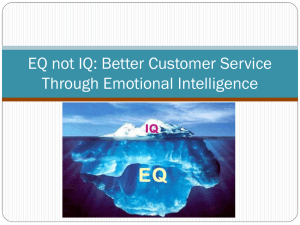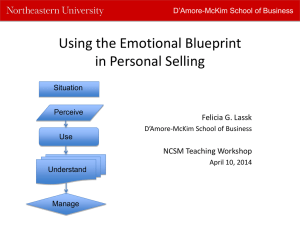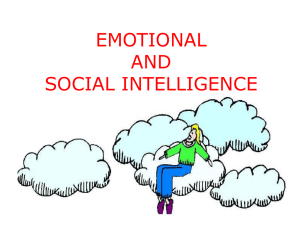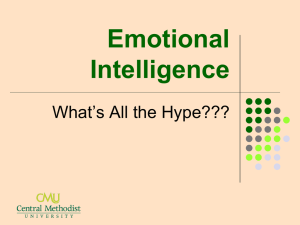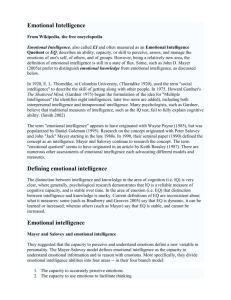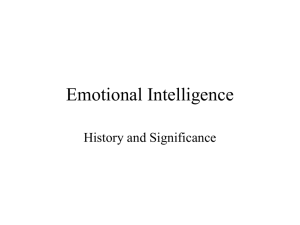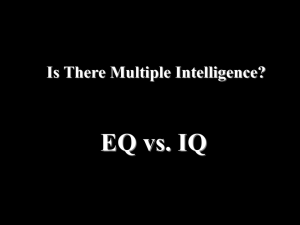Emotional Intelligence Handouts
advertisement
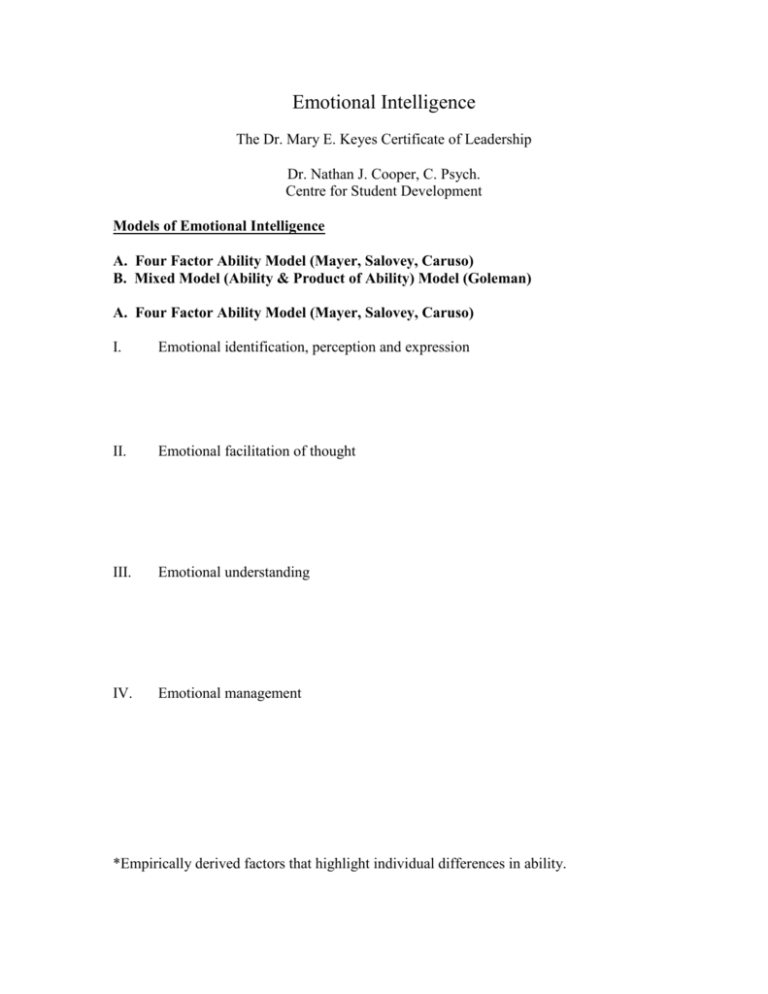
Emotional Intelligence The Dr. Mary E. Keyes Certificate of Leadership Dr. Nathan J. Cooper, C. Psych. Centre for Student Development Models of Emotional Intelligence A. Four Factor Ability Model (Mayer, Salovey, Caruso) B. Mixed Model (Ability & Product of Ability) Model (Goleman) A. Four Factor Ability Model (Mayer, Salovey, Caruso) I. Emotional identification, perception and expression II. Emotional facilitation of thought III. Emotional understanding IV. Emotional management *Empirically derived factors that highlight individual differences in ability. B. Mixed Model (Ability & Product of Ability) Model (Goleman) EI Domains and Associated Competencies Personal Competence Self-awareness Emotional – aware of one’s emotions, recognizing their impact, and using gut to guide decision making Self-assessment – knowing personal strengths and limitations Self-confidence – sense of self-worth and capabilities Self-management Emotional – managing/ controlling disruptive emotions and impulses Transparency – honesty, integrity, trustworthiness Adaptability – flexible in changing situations/ overcoming obstacles Achievement – drive to improve performance excellence Initiative – ready to act Optimism – recognize/ emphasize the positive Social Competence Social awareness Empathy – sensing the emotions of others, expressing interest in their concerns Organizational – recognizing the currents, networks, and politics of an organization Service – recognizing and meeting client needs Relationship management Inspiration – guide and motivate with vision Influence – multiple persuasion tactics Developing others – improving the abilities of others through feedback and guidance Catalyst – initiating/ leading in new direction Conflict management – resolve disagreements Collaboration – foster cooperation and team building Developing Emotional Intelligence Label your feelings rather than people or situations. Distinguish between thoughts and feelings Take responsibility for your feelings Use your feelings to help make decisions Show respect for the feelings of others Convert anger to energy Validate the feelings of others Tune in and fine tune your emotions Avoid advice, commands, control, criticism, judgment, and lectures to self and others Avoid people who invalidate you References/ Reading List Caruso, D.R., Mayer, J.D., & Salovey, P. (2002). Emotional Intelligence and Emotional Leadership. In R.E. Riggio, S.E., Murphy, & F.J. Pirozzolo, (Eds.) Multiple Intelligences and Leadership. Mahwah, NJ: Lawrence Erlbaum Associates, pp. 55-74. Goleman, D., Boyatzis, R., & McKee, A. (2002). Primal Leadership. Boston, MA: Harvard Business School Press. Gregory, A. (2003). Touchy-feely Brainy? Works Management. 56(11), 38-41. Mayer, J.D., & Salovey, P. (1997). What is Emotional Intelligence? In P. Salovey & D.J. Sluyter (Eds.) Emotional Development and Emotional Intelligence. New York: Basic Books, pp 3-31. Mayer, J.D., Salovey, P., & Caruso, D. (2000). Models of Emotional Intelligence. In R. Sternberg (Ed.) Handbook of Intelligence. Cambridge, UK: Cambridge University Press. Mayer, J.D., Caruso, D., & Salovey, P. (2000). Emotional Intelligence Meets Traditional Standards for an Intelligence. Intelligence, 27(4), 267-298 Details regarding the four factors and test structure of the MSCEIT, taken from: http://www.eiconsortium.org/measures/msceit.htm Sample MSCEIT items, taken from: http://www.emotionaliq.com/MSCEIT.htm EQ international is a group of volunteers in several countries who are interested in emotions, emotional needs and emotional intellingence. http://www.eqi.org/index.htm Multi health systems is a company dedicated to the development, marketing, and delivery of high-quality, standardized and integrated assessment and diagnostic products as well as practice and treatment management products and services. http://www.mhs.com/ Tapia, M. (2001). Measuring emotional intelligence. Psychological reports, 88, 353364.
